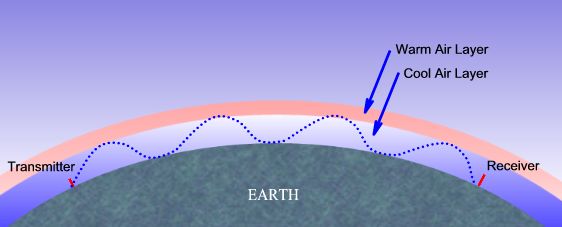See blogpost for more background:
wow… incredible with only only 25mW !
Brilliant! I’ve given some presentations lately in which I’ve mentioned the theoretical maximum distance (800 km) - how cool it would be if somebody broke that theoretical barrier 
I don’t want to discredit the merit, 702Km and 148 gateways redundancy is incredible.
But the transmitter is at 38Km altitude, enough to save the curvature of the Earth.
702Km in LOS Line-Of-Sight propagation over a clear Fresnel zone.

Recently the record with sigfox was 1258Km at ground level, without using high-altitude balloons.
In this case the curvature of the Earth is so big that LOS is impossible, it is using duct propagation in which the signal bounces between the ionosphere and the sea or between cool and warm air layers


Only a matter of time before it happens to LoRaWAN too 
Weather (rain !) is an additional factor that affects the propagation of radio waves.
http://www.tpub.com/neets/book10/40j.htm
if we have a ‘propagation’ node and a known gateway, just sampling the RSSI and SNR with one byte packets, can you relate that data to the actual weather ? just thinking … 

Rain does not have a significant attenuation effect until circa 5Ghz+
Anyone know what it would be for 434Mhz or 868Mhz, I am guessing at maybe 0.001dB/km for heavy rain ?
Maybe we can ask Elon Musk to incorporate TTN gateways in his upcoming internet satellite constellation? After all Low Earth Orbit is only 600km away  .
.
At ECPA 2017, the 11th European Conference on precision agriculture, CENSIS, Scotland’s Rural College (SRUC) and Inmarsat partners will demonstrate a range of uses for sensor systems and LoRa wide area networks in agriculture.
During the event, there will live demonstrations from Kirkton, one of six research farms owned by SRUC across Scotland to showcase the transmission and long range capability of LoRa, and sensors will also be installed throughout the convention area.
Inmarsat’s connectivity will be highlighted as a real alternative to enable IoT at low cost when fibre and cellular aren’t available or the best option. Connecting the LoRa gateway to a Broadband Global Area Network (BGAN) terminal, Inmarsat will transmit data via satellite to the analytics dashboards at the ECPA show.
Its an interesting question.
As far as I know LoRa has not been used in space as yet, and due to the way that LoRa works there are potential issues with doppler shift, particularly as a transmitter or receiver moves overhead a ground station.
I was trying to persuade the ESA to give it a go, last I heard they were going to try LoRa in a doppler simulator.
The other issue would be whether you would be permitted to use 868Mhz from orbit.
Interesting point about Doppler shift indeed. Maybe could be avoided with tracking antenna’s? Does kinda negate the low-cost aspect though.
A tracking antenna will not help to negate doppler frequency shifts unfortunately.